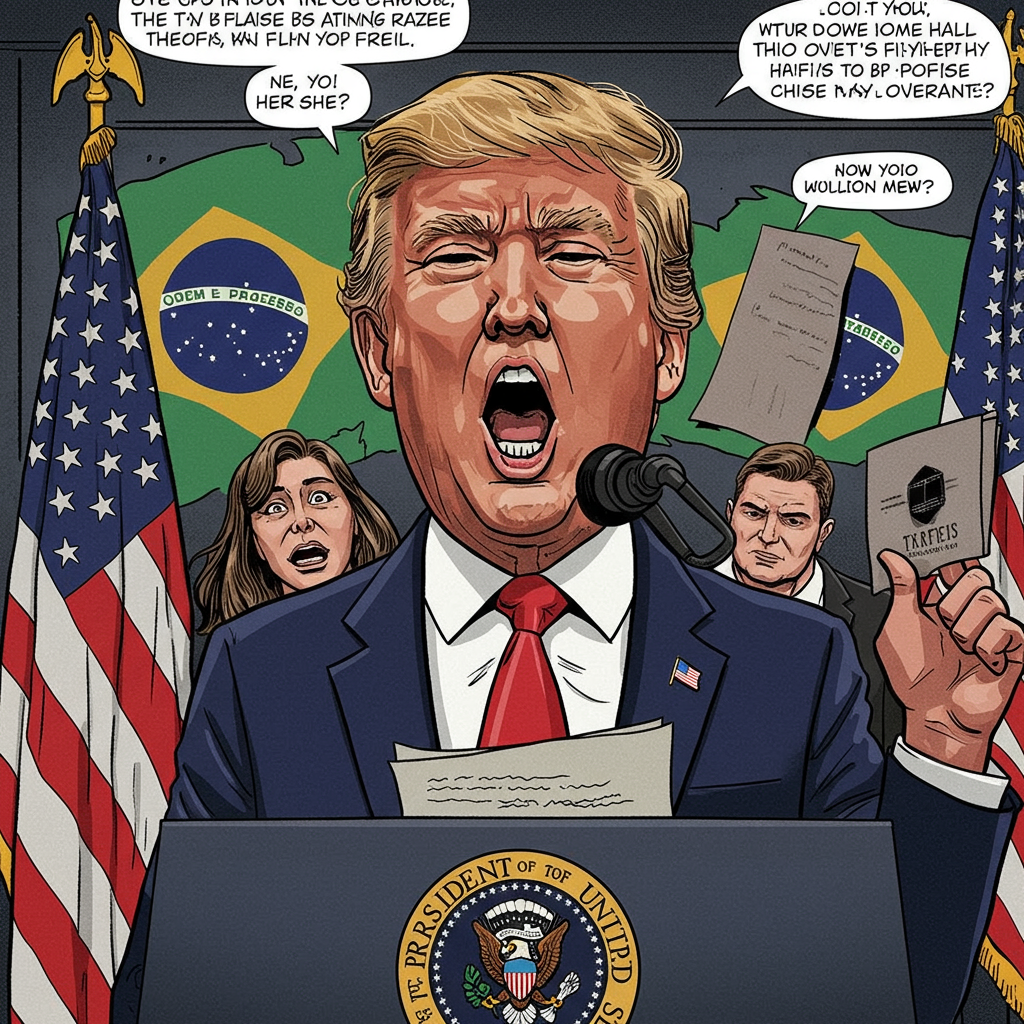President Donald Trump’s suggestion of naming a successor to Federal Reserve chair Jerome Powell significantly before Powell’s term expires in May 2026 has ignited a fierce debate among economic experts. This hypothetical early nominee, quickly dubbed a “shadow Fed chair,” is drawing sharp warnings from seasoned central bankers and financial strategists alike. The core concern? That such a move wouldn’t just be unconventional – it could potentially trigger financial market instability, undermine the Fed’s crucial independence, and even provoke an unprecedented internal conflict within the policymaking ranks.
The former president has publicly stated his intention to select his choice for the top central banker role “very soon.” He has also made his desired policy outcome clear, vowing to pick someone willing to “cut rates” – a departure from Powell’s recent cautious stance. This open preference for lower interest rates, coupled with a history of public criticism directed at Powell for not easing policy, sets the stage for a potentially disruptive transition process. Typically, a new Fed chair nominee is named only about three to four months before the incumbent’s term concludes, placing a typical announcement closer to January ahead of a May expiry. Naming someone now would be dramatically earlier than standard practice.
Why Experts See a “Shadow Fed Chair” as a Terrible Idea
The concept of a “shadow Fed chair” – essentially a designated successor waiting in the wings for over a year – is being met with alarm by those familiar with the intricacies of monetary policy and market dynamics. Princeton professor Alan Blinder, who previously served as the Fed’s vice chair in the 1990s, did not mince words, telling CNN the idea is “an absolutely horrible idea.”
Blinder’s primary concern, echoed by others, is the potential for market confusion. If a named successor publicly articulated a different policy stance than the sitting chair – which seems highly probable given Trump’s stated desire for lower rates versus Powell’s current caution on inflation – markets would be forced to navigate conflicting signals simultaneously. Blinder warned, “If they’re not singing from the same playbook, which seems likely, this is just going to cause confusion in markets.”
This sentiment was seconded by Michael Brown, senior research strategist at Pepperstone. Brown described a shadow chair scenario as “self-defeating,” predicting it would create “chaotic policy rhetoric.” Such lack of clarity, he argued, would further weaken the central bank’s “policy transmission,” making it harder for the Fed’s guidance to effectively influence financial conditions and economic behavior.
The Financial Stability Risks
Beyond mere confusion, experts warn of tangible risks to financial market stability should a shadow Fed chair be named. The Federal Reserve’s reputation for independence from political influence is a cornerstone of its credibility. Any perception that the incoming chair is being explicitly chosen and positioned early for political ends – such as pressuring the Fed to cut rates – would likely be viewed negatively by investors globally.
This perceived increase in political influence could trigger accelerated outflows from both U.S. dollar assets and Treasury bonds. A rush away from these safe-haven assets would push their yields higher, directly translating into increased borrowing costs across the entire U.S. economy, affecting everything from mortgages to corporate loans.
Ironically, Brown suggests that the very act of naming a shadow chair to pressure for lower rates could backfire spectacularly. The mounting external pressure stemming from such a situation might make the current Fed leadership, and even members who will remain under the new chair, more reluctant to deliver a rate cut. This resistance would be rooted in a strong desire to visibly preserve the institution’s policy independence in the face of overt political interference, effectively raising the bar for future easing actions.
Potential for Unprecedented FOMC Conflict
Perhaps the most alarming risk flagged by former Vice Chair Blinder is the potential for an unprecedented internal schism within the Federal Open Market Committee (FOMC). This twelve-member committee is responsible for setting the nation’s monetary policy, including interest rates, and typically operates through consensus or at least unified public messaging despite private disagreements.
Blinder explained that if a shadow chair publicly contradicted Powell’s monetary policy stance or forward guidance, it would likely “aggravate the FOMC.” Crucially, the vast majority of the committee members serving today are expected to remain in their roles when the new chair eventually takes over in 2026. These members value the institution’s independence and process.
He warned that such public dissent from a designated successor “opens the door to an open or silent revolt against the chair.” While disagreements occur, an outright “revolt” against the chair is an exceptionally rare event in the Fed’s history, underscoring the severity of the potential disruption such a scenario could create within the institution itself. This risk of internal conflict is particularly salient given existing, though more subtle, differences in opinion already visible among current Fed officials regarding the appropriate timing for future interest rate adjustments.
Current Economic Context and Powell’s Stance
The backdrop for this discussion includes the current economic climate and Federal Reserve policy posture. While recent positive inflation data has offered some encouragement, Fed Chair Jerome Powell has maintained a cautious stance regarding the timing of interest rate cuts. Testifying recently, Powell indicated that the threat of inflation persists, justifying the central bank’s patient approach.
Despite some pressure and market anticipation, Powell has stressed there is “no rush” to lower rates, citing the continued strength of the U.S. economy and labor market. He has even suggested that he anticipates inflation could move upwards over the summer months, further supporting a wait-and-see approach rather than preemptive action.
This cautious position contrasts with the views of some other Fed officials. Notably, Trump-appointed governors Christopher Waller and Michelle Bowman have publicly suggested that a rate cut might be justified as early as the upcoming July FOMC meeting. In contrast, San Francisco Fed President Mary Daly recently indicated she is looking “more to the fall” for a potential rate cut, preferring to wait for additional economic data. This existing divergence within the Fed membership underscores the potential for more significant conflict if an incoming chair openly pushes a policy agenda sharply opposed to the sitting chair and a significant portion of the current committee.
The Possibility of an Earlier Appointment
While the focus has been on a potentially disruptive “shadow chair” scenario, Treasury Secretary Scott Bessent offered a slightly different perspective. While downplaying the idea of someone acting as a shadow chair, he acknowledged that an earlier appointment is technically possible due to the expiration of Governor Adriana Kugler’s term in early 2026.
This expiring term could open a seat on the Board of Governors that could potentially be filled by the person intended to be the next Fed Chair. Bessent suggested that a nomination could occur in October or November for a January appointment as a governor. While this wouldn’t immediately make the individual “shadow chair,” it could position them within the institution earlier than a typical nomination timeline for the top job, potentially allowing for a smoother eventual transition compared to naming someone completely outside the Fed system far in advance. However, the fundamental risks outlined by experts regarding conflicting messages and political pressure would likely remain if this early appointee publicly diverged from Powell’s line.
Escalating Political Pressure on the Fed
The broader context of this discussion includes increasing political rhetoric surrounding the Federal Reserve. Presidents and politicians have historically criticized the Fed, but observers have noted an intensification of pressure, particularly from President Trump, who has openly demanded lower interest rates and questioned Powell’s performance. This aligns with a wider trend of political figures using pointed language about independent institutions, which Chief Justice John Roberts has warned can have dangerous consequences, even contributing to threats against officials simply performing their duties.
Jeremy Siegel, an emeritus finance professor at the Wharton School, has previously predicted that attacks on Chairman Powell would “escalate a lot,” especially if the Fed doesn’t yield to calls for rate cuts. The potential nomination of a “shadow chair” explicitly chosen for their willingness to cut rates, as Trump has indicated, would represent a significant escalation of this political pressure. Experts like Michael Brown argue that this increased external pressure would ironically make the Fed more determined to demonstrate its independence, potentially reinforcing the reasons for delaying rate cuts even if economic conditions might otherwise allow for them. The risk is that the act intended to force policy change could instead make it harder.
Frequently Asked Questions
What does “shadow Fed chair” mean in this context?
In this context, “shadow Fed chair” refers to the idea of President Donald Trump naming his pick to succeed current Federal Reserve Chair Jerome Powell significantly earlier than the typical timeline, well before Powell’s term expires in May 2026. This designated successor might then be expected to publicly articulate views on monetary policy before officially taking office, potentially conflicting with the current chair.
Why are experts concerned about a shadow Fed chair appointment?
Experts like former Fed Vice Chair Alan Blinder and strategist Michael Brown warn that naming a shadow chair could cause severe market confusion due to potentially conflicting messages between the incumbent and successor. They also fear it would weaken the Fed’s ability to guide the economy, destabilize financial markets by signaling political interference, potentially increase borrowing costs, and risk an unprecedented internal conflict or “revolt” among current Fed policymakers on the FOMC who will remain under the new chair.
Could someone be appointed to the Fed early, even without being a “shadow chair”?
Yes, Treasury Secretary Scott Bessent noted that an earlier appointment to the Federal Reserve Board of Governors is possible due to the expiration of Governor Adriana Kugler’s term in early 2026. This could potentially allow the person intended to be the next chair to be nominated in late 2025 and appointed as a governor in January 2026, positioning them within the institution earlier, although this differs from the concept of a public “shadow chair” expressing policy views from outside the current structure.
Conclusion
The prospect of President Trump naming a “shadow Fed chair” years ahead of the typical transition timeline is being met with strong warnings from economic experts. Former Fed Vice Chair Alan Blinder and strategist Michael Brown articulate significant risks, ranging from market confusion and financial instability to potential internal conflict within the FOMC. Such a move, explicitly tied to a desire for lower interest rates, would challenge the Federal Reserve’s carefully guarded independence. While Treasury Secretary Scott Bessent points to the technical possibility of an earlier governor appointment due to a term expiry, the core concerns remain: politicizing the transition process risks undermining the Fed’s credibility and effectiveness at a critical time for the U.S. economy. The value of an independent central bank, free from short-term political pressures, is paramount for maintaining stable markets and implementing sound monetary policy. Any action perceived to erode that independence could have far-reaching and detrimental consequences.
Word Count Check: Approximately 1100 words



